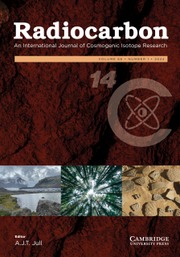Crossref Citations
This article has been cited by the following publications. This list is generated based on data provided by
Crossref.
Fontes, D.
Cordeiro, R.C.
Martins, G.S.
Behling, H.
Turcq, B.
Sifeddine, A.
Seoane, J.C.S.
Moreira, L.S.
and
Rodrigues, R.A.
2017.
Paleoenvironmental dynamics in South Amazonia, Brazil, during the last 35,000 years inferred from pollen and geochemical records of Lago do Saci.
Quaternary Science Reviews,
Vol. 173,
Issue. ,
p.
161.
Lima, W.J.S.
Cohen, M.C.L.
Rossetti, D.F.
and
França, M.C.
2018.
Late Pleistocene glacial forest elements of Brazilian Amazonia.
Palaeogeography, Palaeoclimatology, Palaeoecology,
Vol. 490,
Issue. ,
p.
617.
Rossetti, Dilce F.
Gribel, Rogério
Toledo, Peter M.
Tatumi, Sonia H.
Yee, Márcio
Tudela, Diego R. G.
Munita, Casimiro S.
and
de Souza Coelho, Luiz
2018.
Unfolding long‐term Late Pleistocene–Holocene disturbances of forest communities in the southwestern Amazonian lowlands.
Ecosphere,
Vol. 9,
Issue. 10,
Soares Cruz, Anna Paula
Fernandes Barbosa, Cátia
Blanco, Angélica Maria
de Oliveira, Camila Areias
Guizan Silva, Cleverson
and
Sícoli Seoane, José Carlos
2019.
Mid–late Holocene event registered in organo-siliciclastic sediments of Lagoa Salgada carbonate system, southeast Brazil.
Climate of the Past,
Vol. 15,
Issue. 4,
p.
1363.
Rossetti, Dilce de Fátima
Gribel, Rogério
Cohen, Marcelo Cancela Lisboa
Valeriano, Márcio de Morisson
Tatumi, Sonia Hatsue
and
Yee, Marcio
2019.
The role of Late Pleistocene-Holocene tectono-sedimentary history on the origin of patches of savanna vegetation in the middle Madeira River, southwest of the Amazonian lowlands.
Palaeogeography, Palaeoclimatology, Palaeoecology,
Vol. 526,
Issue. ,
p.
136.
Maksic, Jelena
Shimizu, Marilia Harumi
de Oliveira, Gilvan Sampaio
Venancio, Igor Martins
Cardoso, Manoel
and
Ferreira, Felipe Alexandre
2019.
Simulation of the Holocene climate over South America and impacts on the vegetation.
The Holocene,
Vol. 29,
Issue. 2,
p.
287.
Perini, Fernando A.
Nascimento, Ednair Rodrigues
and
Cozzuol, Mario Alberto
2019.
A new species of Trichechus Linnaeus, 1758 (Sirenia, Trichechidae), from the upper Pleistocene of southwestern Amazonia, and the evolution of Amazonian manatees.
Journal of Vertebrate Paleontology,
Vol. 39,
Issue. 5,
p.
e1697882.
de Medeiros, Larissa A.
Ribas, Camila C.
and
Lima, Albertina P.
2021.
Genetic Diversification of Adelphobates quinquevittatus (Anura: Dendrobatidae) and the Influence of Upper Madeira River Historical Dynamics.
Evolutionary Biology,
Vol. 48,
Issue. 3,
p.
269.
Dallmeyer, Anne
Claussen, Martin
Lorenz, Stephan J.
Sigl, Michael
Toohey, Matthew
and
Herzschuh, Ulrike
2021.
Holocene vegetation transitions and their climatic drivers in MPI-ESM1.2.
Climate of the Past,
Vol. 17,
Issue. 6,
p.
2481.
Asevedo, Lidiane
Ranzi, Alceu
Kalliola, Risto
Pärssinen, Martti
Ruokolainen, Kalle
Cozzuol, Mário Alberto
Nascimento, Ednair Rodrigues do
Negri, Francisco Ricardo
Souza-Filho, Jonas P.
Cherkinsky, Alexander
and
Trindade Dantas, Mário André
2021.
Isotopic paleoecology (δ13C, δ18O) of late Quaternary herbivorous mammal assemblages from southwestern Amazon.
Quaternary Science Reviews,
Vol. 251,
Issue. ,
p.
106700.
Soares, Juliano HF
Moreira, Luciane S
Turcq, Bruno
Moreira-Turcq, Patricia
Sifeddine, Abdel
Dornellas, Nayara
Evangelista, Heitor
Nogueira, Juliana
Aniceto, Keila
Martins, Gabriel S
Kury, Milena S
Brandini, Nilva
Contrera, Júlia M
and
Cordeiro, Renato C
2022.
Development of lacustrine primary productivity in the Amazon Basin during the Holocene.
The Holocene,
Vol. 32,
Issue. 7,
p.
639.
Dalapicolla, Jeronymo
Weir, Jason T.
Vilaça, Sibelle Torres
Quaresma, Tânia Fontes
Schneider, Maria P. C.
Vasconcelos, Ana Tereza R.
and
Aleixo, Alexandre
2024.
Whole genomes show contrasting trends of population size changes and genomic diversity for an Amazonian endemic passerine over the late quaternary.
Ecology and Evolution,
Vol. 14,
Issue. 4,
Asevedo, Lidiane
Longstaffe, Fred J.
Semprebon, Gina M.
D'Apolito, Carlos
Guilherme, Edson
Negri, Francisco Ricardo
Ranzi, Alceu
de Souza Filho, Jonas P.
and
Dantas, Mário André Trindade
2024.
A multiproxy approach for the feeding ecology of Late Miocene ground sloths from the southwestern Amazonia, Upper Solimões Formation, Brazil.
Palaeogeography, Palaeoclimatology, Palaeoecology,
Vol. 654,
Issue. ,
p.
112458.
Ramos, R. Soledad
Via do Pico, Gisela M.
Brea, Mariana
and
Kröhling, Daniela M.
2024.
New fossil woods (upper Pleistocene) from the lower-middle Uruguay river basin (South America) reveal the past distribution of Aspidosperma (Apocynaceae).
Quaternary International,
Vol. 697,
Issue. ,
p.
19.
MEDEIROS, LARISSA A. DE
GENTIL, EDUARDO
KAEFER, IGOR L.
and
COHN-HAFT, MARIO
2024.
Distribution and diversification of Adelphobates, emblematic poison frogs from Brazilian Amazonia.
Anais da Academia Brasileira de Ciências,
Vol. 96,
Issue. 1,
Vasconcelos, B. D.
Camurugi, F.
Mudrek, J. R.
Brandão, R. A.
and
Santana, D. J.
2025.
Rivers and spatial distance are drivers of genetic diversity in the South American dwarf caiman (Paleosuchus palpebrosus).
Journal of Zoology,
Vol. 325,
Issue. 1,
p.
36.

